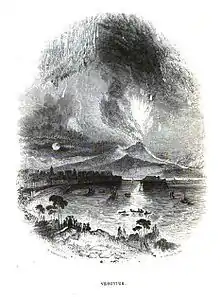William Henry Powis
William Henry Powis (1808–1836) was a British wood engraver. He was regarded as one of the best in the profession in his day.[1] His early death at age 28, according to William James Linton, was caused by consumption.[2]
Life
Powis was born in London, and trained by George Wilmot Bonner. He then worked for John Jackson, who may have published some of Powis's wood-engravings as his own.[2]
Works

Mount Vesuvius, wood engraving by William Henry Powis after William Harvey, for The Solace of Song (1837) by Charles Latrobe[2]
Powis's wood-engravings appeared as illustrations in:
- Francis Douce, The Dance of Death (1833), after Hans Holbein (with Bonner);[2]
- James Northcote, Fables;[2]
- Edward Turner Bennett, The Gardens and Menageries of the Zoological Society Delineated (1830–31);[2]
- John Martin and Richard Westall's Pictorial Illustrations of the Bible, (1833);[1]
- Thomas Scott's Bible, edition of 1834.[1]
Notes
- Lee, Sidney, ed. (1896). . Dictionary of National Biography. Vol. 46. London: Smith, Elder & Co.
- Avery-Quash, Susanna. "Powis, William Henry". Oxford Dictionary of National Biography (online ed.). Oxford University Press. doi:10.1093/ref:odnb/22672. (Subscription or UK public library membership required.)
Wikimedia Commons has media related to William Henry Powis.
- Attribution
![]() This article incorporates text from a publication now in the public domain: Lee, Sidney, ed. (1896). "Powis, William Henry". Dictionary of National Biography. Vol. 46. London: Smith, Elder & Co.
This article incorporates text from a publication now in the public domain: Lee, Sidney, ed. (1896). "Powis, William Henry". Dictionary of National Biography. Vol. 46. London: Smith, Elder & Co.
This article is issued from Wikipedia. The text is licensed under Creative Commons - Attribution - Sharealike. Additional terms may apply for the media files.